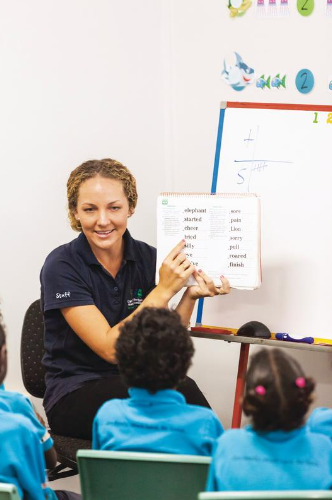Back to Course
Practice Provide Positive Praise and Affirmations
0% Complete
0/0 Steps
-
Module Introduction2 Topics
-
Delivered With Fidelity15 Topics|2 Tests
-
Cover
-
Module Objective
-
What Happens When Positive Praise and Affirmations Are Provided With Fidelity?
-
How to Provide Positive Praise and Affirmations
-
Using Affirmations in Lessons
-
The Teacher Teaches Expected Behaviours
-
The Teacher Teaches Expected Behaviours: Example
-
The Teacher Delivers Lessons Fluently While Providing Praise
-
The Teacher Delivers Lessons Fluently While Providing Praise: Example
-
Providing Positive Praise Throughout the Day
-
Students Are Confident, Engaged Learners and Have Appropriate Behaviour
-
Students Are Confident, Engaged Learners and Have Appropriate Behaviour: Example
-
The Teacher Contributes to Building a High Expectations School Culture
-
Check Your Understanding
-
Test Your Understanding
-
Cover
-
Not Delivered With Fidelity11 Topics|2 Tests
-
Cover
-
What Happens When a Technique is not Delivered with Fidelity
-
The Teacher does not Promote Expected Behaviours
-
The Teacher does not Promote Expected Behaviours: Example
-
Teachers are not Practising Adequately to Improve their Practice
-
Teachers are not Practising Adequately to Improve their Practice: Example
-
Students are not Confident, Engaged Learners and do not have Appropriate Behaviour
-
Students are not Confident, Engaged Learners and do not have Appropriate Behaviour: Example
-
The Teacher does not Contribute to Building a High-Expectations School Culture
-
Check Your Understanding
-
Test Your Understanding
-
Cover
-
Barriers That Impede Fidelity9 Topics|2 Tests
-
Cover
-
Barriers that Impede Delivering the Technique with Fidelity
-
Using Deductive Logic to Identify the Cause of the Barrier
-
Not Understanding why Providing Positive Praise and Affirmations is Required
-
Do not Know how to Provide Positive praise and Affirmations
-
Unfamiliar with Lesson Content so Unable to Provide Positive Praise or Affirmations
-
Not Providing Positive Praise Leads to more Incidences of Inappropriate Behaviour
-
Check Your Understanding
-
Test Your Understanding
-
Cover
-
Removing Barriers That Impede Fidelity15 Topics|2 Tests
-
Cover
-
Ways to Tackle Barriers So That the Technique Is Delivered With Fidelity
-
Teachers Learn Why Positive Praise and Affirmations Are Required
-
Process
-
Understand How to Give Positive Praise and Affirmations
-
Process
-
Become Familiar With the Lesson to Be Able to Add Specific Positive Praise and Affirmations
-
Prepare for the Lesson Process
-
Practice Delivery Process
-
Lesson Practise While Adding Positive Praise
-
Prevent and Manage Inappropriate Behaviour
-
Prevent and Manage Inappropriate Behaviour Process
-
Check Your understanding
-
Test Your Understanding
-
Lesson Completed
-
Cover
-
Module Completion Survey1 Topic
Participants 439
Lesson 2,
Topic 4
In Progress
How to Provide Positive Praise and Affirmations
ddewell@goodtogreatschools.org.au August 7, 2023
Lesson Progress
0% Complete

How to Provide Positive Praise and Affirmations.
Effective teachers motivate students with praise. By recognising students’ efforts, teachers increase their awareness of it and amplify the effects of student success.
Affirmations
The process is as follows:
After a student/s says the correct answer, the teacher says, ‘Yes’ and repeats the answer.

Specific Positive Praise
The process is:
- based on what the child is doing well in a positive way so it can be replicated in the future
- descriptive of the child’s skill, effort and work-products
- short, sincere and conveyed with enthusiasm
- provided frequently, focuses on what students can control, and shows them that hard work pays off
- individualised based on the child’s needs (for example, visual supports, verbal statements, close proximity) and preferences (for example, whether the child is comfortable being praised in front of others or prefers private recognition.
When to use specific positive praise.
- Contingently. Students “earn” specific positive feedback and consequences, so provide it only when students have demonstrated the required behaviour to ensure they sustain the skills that they have learned.
- Immediately. Specific positive feedback is delivered soon after the behaviour was demonstrated so that students can connect what they did with the feedback they are receiving. This is especially important for younger students.
- Frequently. Feedback is more frequent when students are learning a new behaviour or skill. The student receives positive feedback every time they display the desired behaviour. Less feedback is required as the behaviour becomes the norm.
- Intermittently. Once the skill or behaviour has been learned, it becomes the norm, so only general praise and occasional use of specific positive feedback is required.

